| Solar eclipse of August 21, 1914 | |
|---|---|
 Map | |
| Type of eclipse | |
| Nature | Total |
| Gamma | 0.7655 |
| Magnitude | 1.0328 |
| Maximum eclipse | |
| Duration | 134 sec (2 m 14 s) |
| Coordinates | 54°30′N 27°06′E / 54.5°N 27.1°E |
| Max. width of band | 170 km (110 mi) |
| Times (UTC) | |
| Greatest eclipse | 12:34:27 |
| References | |
| Saros | 124 (49 of 73) |
| Catalog # (SE5000) | 9314 |
A total solar eclipse occurred on August 21, 1914. A solar eclipse occurs when the Moon passes between Earth and the Sun, thereby totally or partly obscuring the image of the Sun for a viewer on Earth. A total solar eclipse occurs when the Moon's apparent diameter is larger than the Sun's, blocking all direct sunlight, turning day into darkness. Totality occurs in a narrow path across Earth's surface, with the partial solar eclipse visible over a surrounding region thousands of kilometres wide. The totality of this eclipse was visible from northern Canada, Greenland, Norway, Sweden, Russian Empire (the parts now belonging to Åland, Finland, Estonia, Latvia, Lithuania, Belarus, Ukraine and Russia, including cities of Riga, Minsk, Kiev and northeastern part of Vilnius), Ottoman Empire (the parts now belonging to Turkey, northeastern tip of Syria and northern Iraq), Persia and British Raj (the parts now belonging to Pakistan and western tip of India). It was the first of four total solar eclipses that would be seen from Sweden during the next 40 years. This total solar eclipse occurred in the same calendar date as 2017, but at the opposite node. The moon was just 2.7 days before perigee, making it fairly large.
Several astronomers were setting up to observe the eclipse, in part as an attempt to confirm Albert Einstein's theory of general relativity. However, due to the onset of World War I as well as cloud cover, these experiments were unsuccessful.
Observations
A number of observatories sent expeditions to Russia to observe the eclipse including those from Argentina, the United Kingdom, Germany, Russia, and the United States. The expeditions led by Charles Dillon Perrine of the Argentine National Observatory, Erwin Finlay-Freundlich of the Berlin-Babelsberg Observatory, Germany, and William W. Campbell of the Lick Observatory, California, included in their programs the second attempt to verify the general relativity theory of Albert Einstein. (Perrine had made the first attempt at the 1912 solar eclipse in Brazil.[1]) However, World War I broke out and Freundlich and his equipment were interned in Russia, unable to carry out the necessary measurements. C. D. Perrine and W. W. Campbell, from neutral countries, Argentina and the United States, were permitted to continue with their plans, but clouds obscured the eclipse.[1][2] Perrine was able to obtain one photograph of the eclipse but the thin cloud cover was enough to obscure star locations necessary to test Einstein's theory.[3]
Related eclipses
Solar eclipses of 1913–1917
This eclipse is a member of a semester series. An eclipse in a semester series of solar eclipses repeats approximately every 177 days and 4 hours (a semester) at alternating nodes of the Moon's orbit.[4]
| Solar eclipse series sets from 1913–1917 | ||||
|---|---|---|---|---|
| Descending node | Ascending node | |||
| 114 | August 31, 1913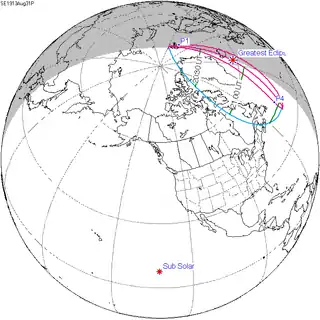 Partial |
119 | February 25, 1914 Annular | |
| 124 | August 21, 1914 Total |
129 | February 14, 1915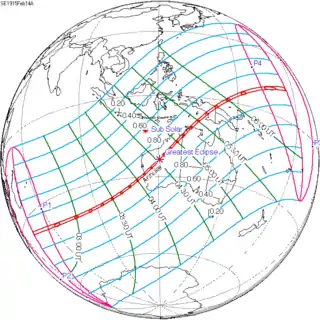 Annular | |
| 134 | August 10, 1915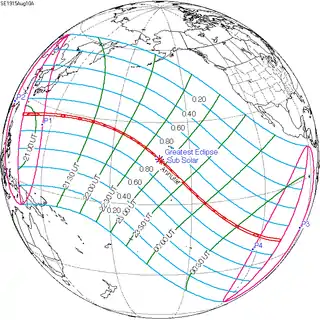 Annular |
139 | February 3, 1916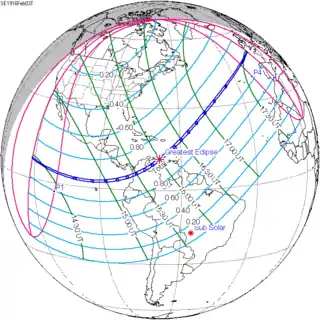 Total | |
| 144 | July 30, 1916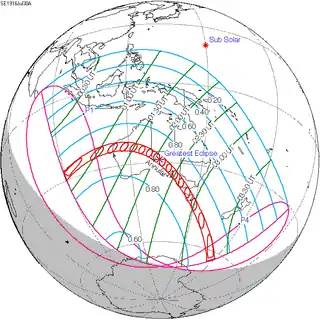 Annular |
149 | January 23, 1917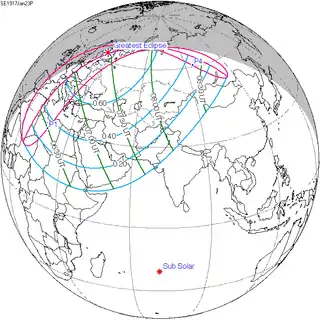 Partial | |
| 154 | July 19, 1917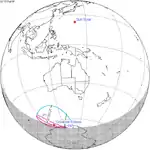 Partial | |||
Saros 124
Solar saros 124, repeating every about 18 years and 11 days, contains 73 events. The series started with partial solar eclipse on March 6, 1049. It contains total eclipses from June 12, 1211, to September 22, 1968, and a hybrid solar eclipse on October 3, 1986. The series ends at member 73 as a partial eclipse on May 11, 2347. The longest total eclipse occurred on May 3, 1734, at 5 minutes and 46 seconds.[5]
| Series members 43–59 occur between 1801 and 2100: | ||
|---|---|---|
| 43 | 44 | 45 |
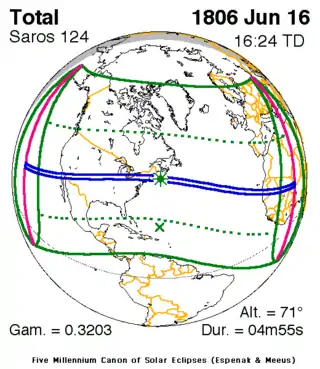 June 16, 1806 |
 June 26, 1824 |
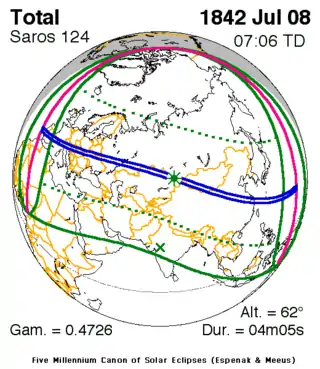 July 8, 1842 |
| 46 | 47 | 48 |
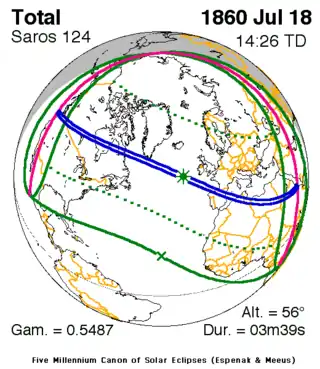 July 18, 1860 |
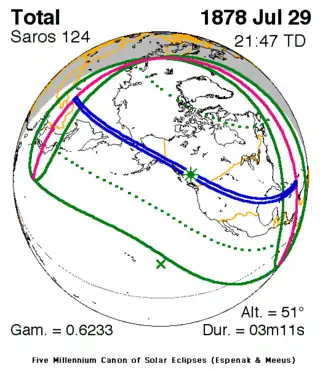 July 29, 1878 |
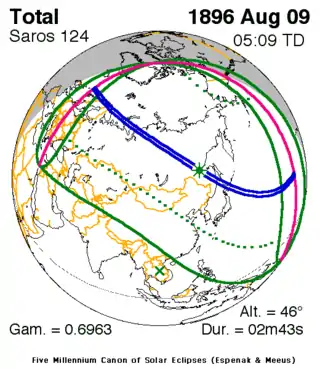 August 9, 1896 |
| 49 | 50 | 51 |
 August 21, 1914 |
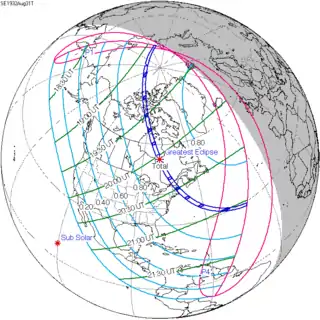 August 31, 1932 |
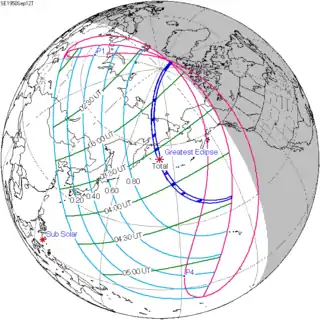 September 12, 1950 |
| 52 | 53 | 54 |
 September 22, 1968 |
 October 3, 1986 |
 October 14, 2004 |
| 55 | 56 | 57 |
 October 25, 2022 |
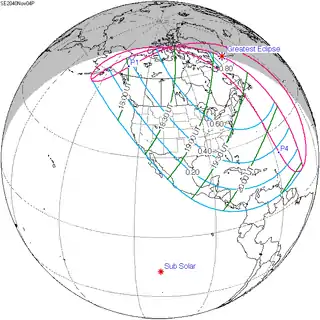 November 4, 2040 |
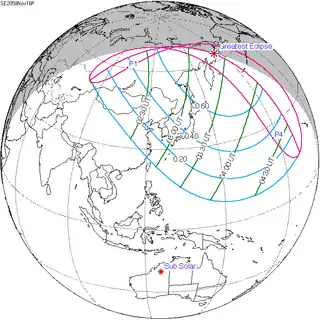 November 16, 2058 |
| 58 | 59 | |
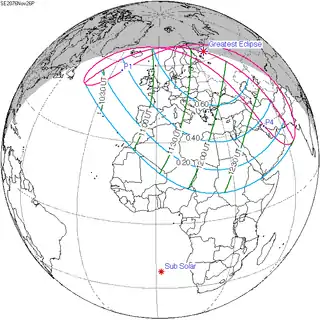 November 26, 2076 |
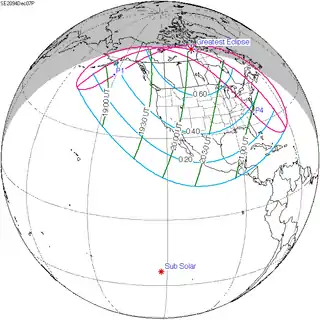 December 7, 2094 | |
Tritos series
This eclipse is a part of a tritos cycle, repeating at alternating nodes every 135 synodic months (≈ 3986.63 days, or 11 years minus 1 month). Their appearance and longitude are irregular due to a lack of synchronization with the anomalistic month (period of perigee), but groupings of 3 tritos cycles (≈ 33 years minus 3 months) come close (≈ 434.044 anomalistic months), so eclipses are similar in these groupings.
| Series members between 1901 and 2100 | |||
|---|---|---|---|
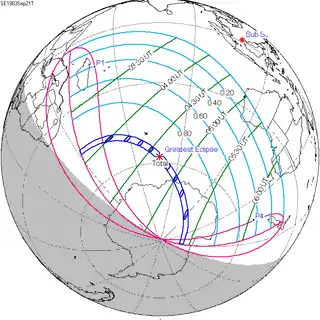 September 21, 1903 (Saros 123) |
 August 21, 1914 (Saros 124) |
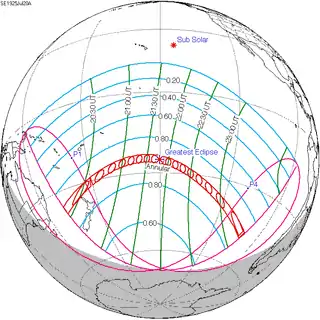 July 20, 1925 (Saros 125) | |
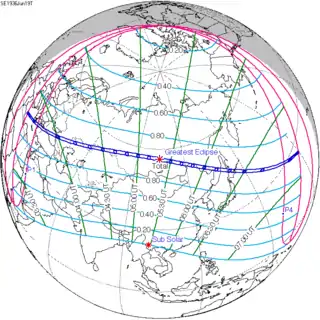 June 19, 1936 (Saros 126) |
 May 20, 1947 (Saros 127) |
 April 19, 1958 (Saros 128) | |
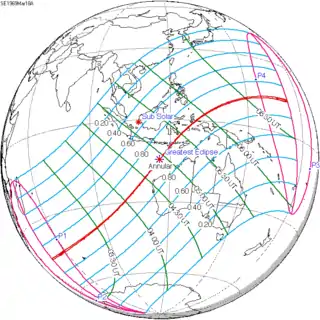 March 18, 1969 (Saros 129) |
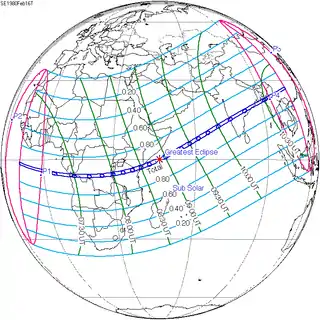 February 16, 1980 (Saros 130) |
 January 15, 1991 (Saros 131) | |
 December 14, 2001 (Saros 132) |
 November 13, 2012 (Saros 133) |
 October 14, 2023 (Saros 134) | |
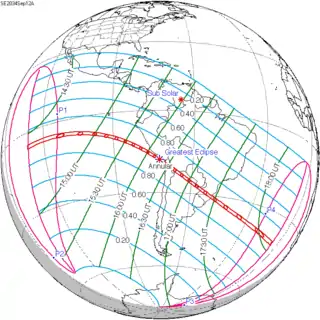 September 12, 2034 (Saros 135) |
 August 12, 2045 (Saros 136) |
 July 12, 2056 (Saros 137) | |
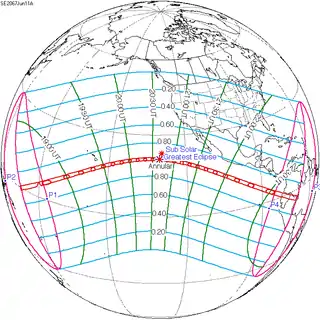 June 11, 2067 (Saros 138) |
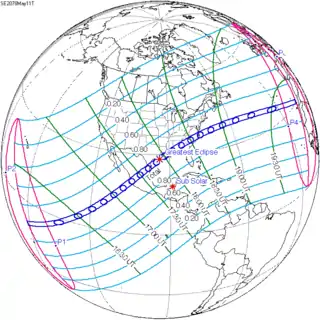 May 11, 2078 (Saros 139) |
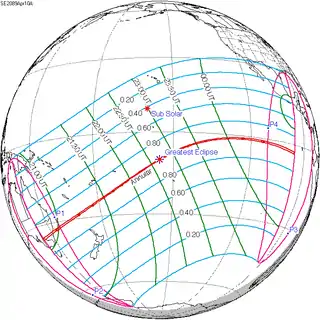 April 10, 2089 (Saros 140) | |
 March 10, 2100 (Saros 141) |
|||
References
- 1 2 Perrine, Charles D. (1923). "Contribution to the history of attempts to test the theory of relativity by means of astronomical observations". Astronomische Nachrichten. 219 (17): 281–284. Bibcode:1923AN....219..281P. doi:10.1002/asna.19232191706.
- ↑ Campbell, W.W.; Curtis, H.D. (1914). "The Lick Observatory-Crocker Eclipse Expedition to Brovarý, Russia". Publications of the Astronomical Society of the Pacific. 26 (156): 225–237. Bibcode:1914PASP...26..225C. doi:10.1086/122351. S2CID 120712519.
- ↑ Minniti, Edgardo; Paolantonio, Santiago (2013). "Attempts to prove Einstein's Theory of Relativity" (PDF). Córdoba Estelar. Translated by Cuestas, A.D.; Scorians, E.E.; Valotta, M.E. Córdoba, Argentina: Universidad Nacional de Córdoba. pp. 402–425.
- ↑ van Gent, R.H. "Solar- and Lunar-Eclipse Predictions from Antiquity to the Present". A Catalogue of Eclipse Cycles. Utrecht University. Retrieved 6 October 2018.
- ↑ Saros Series Catalog of Solar Eclipses NASA Eclipse Web Site.
- Solar eclipse of August 21, 1914 in Russia (Russian) Archived January 2, 2010, at the Wayback Machine
- Earth visibility chart and eclipse statistics Eclipse Predictions by Fred Espenak, NASA/GSFC
.jpg.webp)

